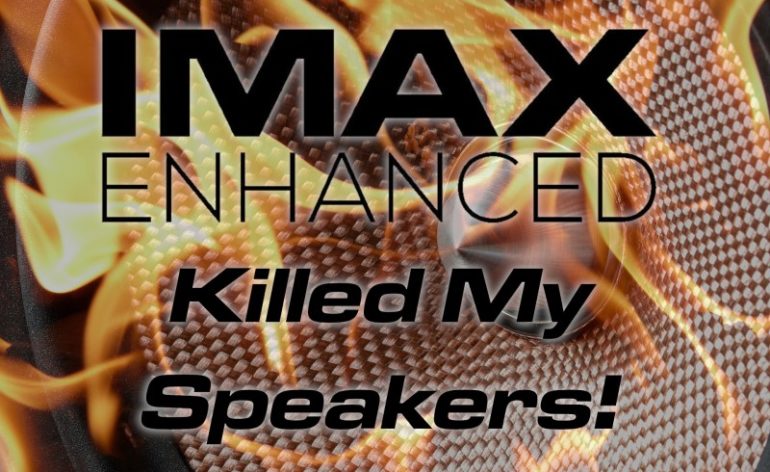What is IMAX Enhanced and Why is it Dangerous for your Speakers?
If I mention IMAX, it probably conjures an image of a massive, multi-story screen and equally massive sound. The only way you could see IMAX was in a theater until recently. However, when I started researching upgrading my AV receiver, many new AV receivers offered an IMAX Enhanced mode. Hmmm, IMAX at home. On paper, it sounds great. But before you slap your money down on the table, let’s discuss. Is IMAX Enhanced worth the extra money, and more importantly, is it dangerous to your speakers?
What Is IMAX?
IMAX (Image Maximum) are high-resolution films, shot in 70mm format (versus 35mm). It’s projected on large-format screens, in a 1.90:1 ratio. The IMAX image is paired with a six-channel DTS track with a top center channel added that takes advantage of the taller aspect ratio. IMAX is big and loud!

What is IMAX Enhanced?
IMAX Enhanced is the IMAX experience at home. IMAX Enhanced movies use HDR combined with a larger aspect ratio to mimic the theater experience. Mastered in an IMAX-specific version of DTS, IMAX Enhanced adds a 12th phantom “top center” to mimic the IMAX theater experience. Think of IMAX Enhanced as the direct competitor for Dolby Vision and Atmos. To use IMAX Enhanced, you need IMAX Enhanced content and an AV reciever capable of receiving and decoding IMAX Enabled content.
In addition to the IMAX Enhanced content and AV receiver, IMAX recommends a large format (minimum 65″) IMAX Enhanced 4K panel and IMAX Enhanced speakers. The certification ensures that the TV can display the content with correct tone mapping and peak brightness. In addition, the speakers have specific SPL, sensitivity, and power handling requirements for the IMAX DTS:X soundtrack demands. IMAX recommends a fully certified system (because money) for the best experience, but the certified speakers and 4K panel are optional.

You Said Something About Damaging My Speakers?!?
So this is where “it depends” really comes into play. IMAX theaters use full-range speakers, which you most likely do not have in your home theater. On top of this, the IMAX version of DTS does not have a dedicated LFE (low-frequency effects or .1) channel. Instead, they run crossovers in the theater and send everything below a specific frequency to the subs. This is different than most movie soundtracks that have dedicated LFE channels specifically for those bass-heavy scenes.
In layman terms, the dangerous part for your speakers of IMAX Enhanced is that it turns off the bass management and internal crossovers managed by your AV receiver. It follows the same principle as the IMAX theater. Sending specific frequencies to the subwoofer (foregoing the dedicated LFE channel) and the rest to the speakers. In my article about speaker crossovers possibly damaging your speakers, I explain how a low-frequency signal could quickly over-extend the driver or push it past its limits, causing damage. The strange thing is that non-IMAX Enhanced DTS:X content has a dedicated LFE channel. This makes us wonder why IMAX Enhanced DTS:X is different.
What Can I Do To Protect My Gear?
Had my editor not assigned me this article, I would not have known that IMAX Enhanced bypasses my crossovers, exposing my speakers to potentially dangerous frequencies. It never would have occurred to me that I needed to protect my speakers from this specific content. I wouldn’t be surprised if this was news to many audio enthusiasts.

That said, I dug into the manuals for several popular AV receivers, and there seems to be a solution, albeit a bit hamfisted. I won’t get into specific steps, as each procedure is different across brands. The one common theme is that you need to bypass all the auto IMAX Enhanced modes and manually set low-pass and high-pass filters for your speakers. Your room correction already did this for every other listening mode, but you have to do it manually for IMAX Enhanced. Just copy those settings into the IMAX menu. But there is a catch!
The bad news is that you can’t access these menus unless you are playing IMAX Enhanced content! That’s right! You have to have an IMAX Enhanced disc or stream playing BEFORE you can access these menus! The good news is that it seems like it remembers the settings once you set the levels. Or, you could do what I did and turn off IMAX Enhanced entirely and enjoy plain ole DTS:X with an LFE channel! Up to you.
Our Take
Right now, this is mostly a non-issue. IMAX Enhanced content is not widely available and only the newest AV receivers support the format. Disney+ upgraded several of the Marvel movies to include IMAX Enhanced video. Right now, it’s only new IMAX aspect ratios, but Disney has promised DTS:X in the future. It doesn’t take a crystal ball to figure out that if Disney starts supporting IMAX Enhanced, it will probably gain support from other studios.
However, as IMAX Enhanced gains popularity, it is wise to look to your AV receiver settings and ensure no rogue crossover settings damage your speakers. You could also be like me and get an AV receiver that doesn’t support IMAX Enhanced and sleep better, knowing that you never have to dig into obscure parts of your menu. Or, ask Rob H at AV Rant Podcast; he has read every manual made! We expect that future AV receivers will correct this confusing setting issue. But for now, this is what we are stuck with.


